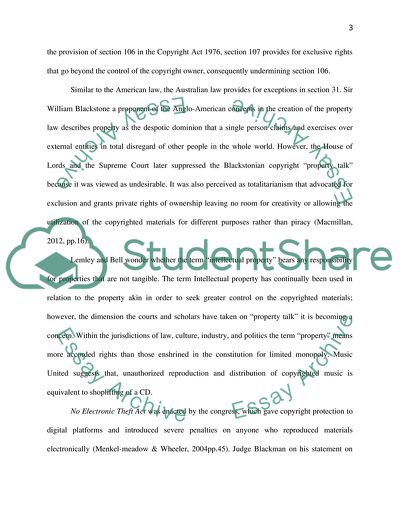Cite this document
(Aims of Copyright Literature review Example | Topics and Well Written Essays - 2250 words - 1, n.d.)
Aims of Copyright Literature review Example | Topics and Well Written Essays - 2250 words - 1. https://studentshare.org/law/1857279-one-of-the-primary-aims-of-copyright-is-to-ensure-society-is-rich-with-creative-works-without-copyright-creators-would-not-create-new-works-discuss-must-following-the-key-concepts-and-use-four-required-readings-sources
Aims of Copyright Literature review Example | Topics and Well Written Essays - 2250 words - 1. https://studentshare.org/law/1857279-one-of-the-primary-aims-of-copyright-is-to-ensure-society-is-rich-with-creative-works-without-copyright-creators-would-not-create-new-works-discuss-must-following-the-key-concepts-and-use-four-required-readings-sources
(Aims of Copyright Literature Review Example | Topics and Well Written Essays - 2250 Words - 1)
Aims of Copyright Literature Review Example | Topics and Well Written Essays - 2250 Words - 1. https://studentshare.org/law/1857279-one-of-the-primary-aims-of-copyright-is-to-ensure-society-is-rich-with-creative-works-without-copyright-creators-would-not-create-new-works-discuss-must-following-the-key-concepts-and-use-four-required-readings-sources.
Aims of Copyright Literature Review Example | Topics and Well Written Essays - 2250 Words - 1. https://studentshare.org/law/1857279-one-of-the-primary-aims-of-copyright-is-to-ensure-society-is-rich-with-creative-works-without-copyright-creators-would-not-create-new-works-discuss-must-following-the-key-concepts-and-use-four-required-readings-sources.
“Aims of Copyright Literature Review Example | Topics and Well Written Essays - 2250 Words - 1”. https://studentshare.org/law/1857279-one-of-the-primary-aims-of-copyright-is-to-ensure-society-is-rich-with-creative-works-without-copyright-creators-would-not-create-new-works-discuss-must-following-the-key-concepts-and-use-four-required-readings-sources.


